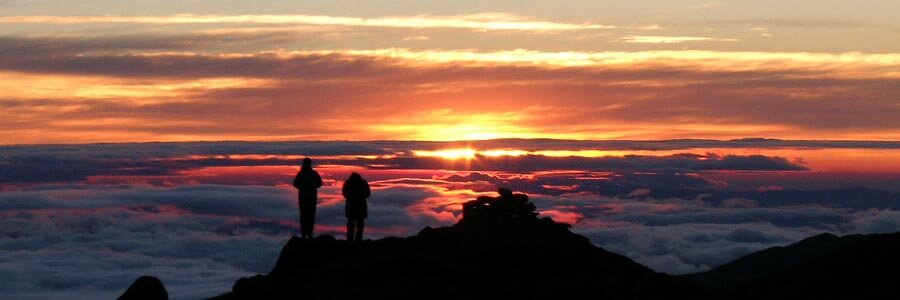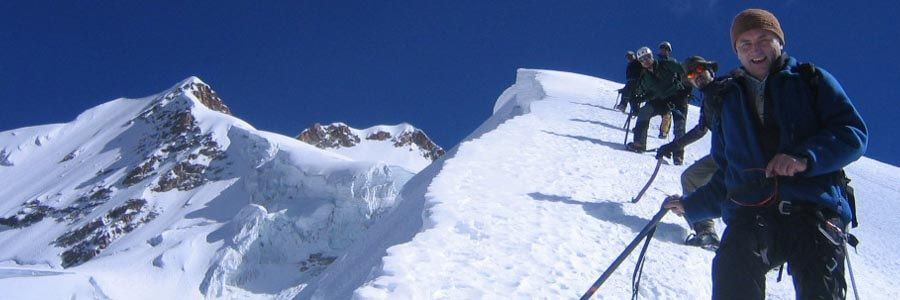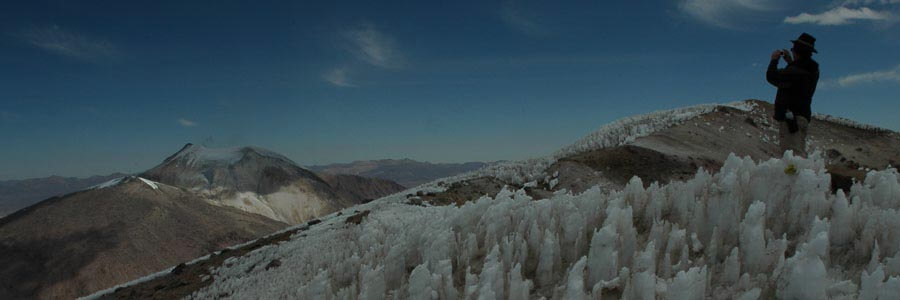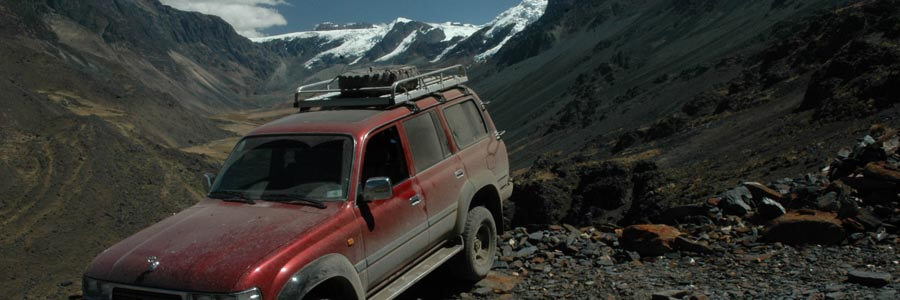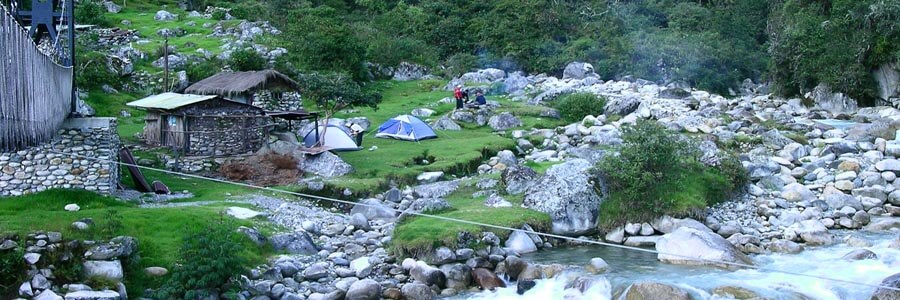Code: MSCONDOR Duration: 6 days

We have chosen Condoriri - one of the most beautiful mountain valleys in Cordillera Real - as our school “campus” not only because of its scenic landscape and its proximity to La Paz, but main of all due to the existence of hundreds of climbing possibilities.
Starting from the same base camp at the shores of Chiar Kota lagoon, we will take you for several days to practice and reinforce technical skills getting ready for the main objective; that is climbing Pequeño Alpamayo in a self-sufficient expedition organized by the clients (of course closely supervised by our instructors).
What would justify you to travel all the way to the Andes to take a climbing course and climb some mountains?.
First of all let us tell you that this is the first and only professional mountaineering school in the Andes. Our instructors have been trained either by the German Alpine Club (Deutschen Alpenvereins, DAV) or the Chamonix climbing and ski school (ENSA). As members of the Bolivian Mountain Guides Association, have got the certification of the International Mountain Guides Association (UIAGM, IMGA, IVBV).
During this short course, you will learn internationally approved mountaineering techniques and – at the same time - visit an exotic destination and meet an ancient culture.
As part of the instruction you will climb Pequeño Alpamayo and get the knowledge of the basic mountaineering techniques: from walking in different type of terrains, rock climbing, snow and ice climbing, glacier travel and basic crevasse rescue techniques.
The day-by-day itinerary also includes detailed information about the instruction content, both theoretical and in the field.
Please note that to take this trip alone, you must already be acclimatized to the highlands. This means that you must have spent at least 3-5 days at the highlands doing light physical activity. For more information about this subject, please refer to the page acclimatization at our website.
We strongly suggest you to extent your trip and add an extension to climb Illimani Mountain MEILLIMA or Sajama volcano MESAJAMA.
Short Itinerary
Day 1. Transport to Condoriri trailhead. Trek to Chiar Kota. Camp.
Day 2. Climb of Austria peak. Camp.
Day 3. Mountaineering techniques Practice. Camp.
Day 4. Mountaineering techniques Practice. Camp.
Day 5. Climb of Pequeño Alpamayo. Camp.
Day 6. Trek to Condoriri trailhead. Transport to La Paz
Highlights
- Knots and rope handle.
- Glacier travel and basic crevasse rescue techniques.
- Snow climbing techniques and self-arrest.
- Ice climbing techniques, use of crampons and ice axes.
- Non technical ascend to Austria peak 5,396m.
- Splendid views of the highlands and Cordillera Real.
- Challenging climb of Pequeño Alpamayo 5,370m.
Services Included
- Meals mentioned in the itinerary.
- Full land transportation during the trip.
- Common camping equipment: 3 season tents (one per each two people), dinning tent, kitchen stuff, and tableware.
- Common climbing equipment: ropes, carabiners, slings, snow stakes, ice screws.
- Professional bilingual UIAGM / IFMGA / IVBV certified mountain guide.
- Luggage transportation with porters and/or animals (15 kg/33 lb per person max weight).
- Cook when camping.
- National Park entrance fees.
Services Not Included
- International & local flight tickets & fees.
- Transfers IN/OUT to airports.
- Meals & hotels while in La Paz.
- Personal camping equipment: sleeping bag, headlamps, and clothing.
- Personal climbing equipment: plastic boots, crampons, harnesses, ice axe.
- Insurance of any kind.
- Any expense due to a rescue operation (rescuers fee, transportation, or medical cost).
Day to day details
Early in the morning we take the high road towards the majestic Andes Mountains that overlook Lake Titicaca. After a short car transfer we will reach the trailhead in Condoriri, there the muleteers and their animals will be waiting to transport our gear to the campsite located at the shores of a lovely lake called “Chiar Kota” (dark Lake). We can help and have a look at them while they prepare the animals and gear for the trek. Immediately after departure, we will get incredible views of Mt. Condoriri and Mt. Huayna Potosi. Lunch will be on a spot with magnificent views over the Condoriri Massif. While we approach we will be all surrounded by beautiful peaks of all levels of technical difficulty, Condoriri resembling a condor with its wide open wings projecting from the rest. For those bursting with energy it is possible to take a short walk around the area.
Overnight: Camping
La Paz 3,650m (11,972ft)
El Alto: 4,100 m (13,450ft)
Condoriri trailhead: 4,400m (14,432ft)
Chiar Kota: 4,650m (15,252ft)
Driving: 3-4Hrs (65km)
Walking: 2-3Hrs (9km)
L,D
Cerro Austria(F) also known as “Cerro Negro” is an easy trekking peak that can be reached via moraines and rock slopes with no technical difficulty. Sometimes there may be some snow on the slopes and gaiters may be required. No climbing equipment is required. The views form this summit tops the views of yesterday’s peak.
Overnight: Camping
Austria: 5,396m (17,698ft)
Chiar Kota: 4,650m (15,252ft)
Walking: 6-7Hrs (8km)
B,L,D
In order to start the ice and snow practice, today we will spend part of the day practicing on a glacier of Tarija peak. At the end of the afternoon we will get back to our camp.
Overnight: Camping
Glacier: 4,800m (15,744ft)
Chiar Kota: 4,650m (15,252ft)
Walking: 3-4Hrs (3.5km)
B,L,D
Another day on the glacier, this time practicing more advanced ice and snow techniques. At the end of the afternoon we will get back to our camp.
Overnight: Camping
Glacier: 4,800m (15,744ft)
Chiar Kota: 4,650 m (15,252 ft)
Walking: 5-6Hrs (3.5km)
B,L,D
This peak was named after Alpamayo mountain in Peru because its similarity, Pequeño (small) Almapayo is one of the most aesthetic peaks of the region. Although as high as Austria, this route is much more technical and will represent a fire-test for the group. After a long and tiring walk to traverse along of the valley through moraines and loose rocks, we will step-on our crampons and roped-up to traverse the whole length of a glacier to climb Tarija peak first. From that point, we will have the best view of the elegant pyramid of Pequeño. The guide will evaluate the weather and climbers condition before continuing. The route descends over loose rock to reach the steep ridge leading to the summit. Although most of the way downhill, the return by no means will be much easier than the ascent.
Overnight: Camping
Tarija Peak: 5,290m (17,351ft)
Col: 5,190m (17,023ft)
Pequeño Almapayo: 5,370m (19,613ft)
Chiar Khota: 4,650m (15,257ft)
Walking: 8-10Hrs (9.5km)
B,L,D
We will retrace our steps towards Condoriri trailhead where our vehicle will be waiting to take us back to La Paz.
Overnight: None
Condoriri headtrail: 4,400m (14,432ft)
La Paz: 3,650m (11,972ft)
Walking: 1-2Hrs (4km)
Driving: 2-3Hrs (65km)
B,L
- General briefing of the course.
- The process of the acclimatization to the altitude.
- The process of learning how to climb.
- Basics of the body metabolism.
- Objective and subjective dangers in the mountains.
- Camping & climbing gear (Clothing, Camping equipment, Ice & rock climbing gear).
- Safety and quality of the equipment (ropes, harnesses, protection, hardware, Karabiners, etc).
- The importance of Communication (discussion over accidents produced because miss-communication).
- How to plan a climbing expedition (Goal, Route, Difficulty, Provisions, Equipment, Personnel, and Transportation).
- Geology of the Andes
- Geography.
- Maps interpretation (Cartography).
- Roped team work.
- Ice, snow, storms, climate.
- Glaciers.
- Mountain sports training (performance capacity, technical & physical training).
- Physics: Climbing gear (ropes, harnesses, slings, carabines), Climbing system (fall impact, friction), Risk and accidents.
- Discussion and evaluation of the course (critics & self-critics).
- Walking over different types of terrain: soft soil, grass, loose stones, gravel, rock, sand (Parallel and crossed steps, Walking aids one or two walking sticks, Rest-step technique).
- Oxygen & energy management (breathing, rhythm, clothing, food).
- Personal equipment check.
- Walking on steep rock using feet and hands.
- Balance of the body, "three points" technique.
- Feet and hands position.
- Basic rock climbing, traversing.
- Basic knots and rope arts, follow through and on-a-bight if apply: (Clove Hitch or Ballestrinque, Munter Hitch or Medio Ballestrinque, Sling knot or Nudo de cinta, double Figure 8 knot or Nudo ocho, Double fisherman or Pescador, Prusik Hitch).
- Walking on ice with and without crampons, ice axe and walking stake. Practice & games (duck step, parallel & crossed steps)
- Self arrest (different: positions, type of terrain, steepness, other complications (i.e. back pack or rope).
- Cutting steps on ice.
- Cramponing techniques (French technique / German - front pointing technique)
- Ice axe techniques (support, Anchor, broom, stairs hand-rail, improvisation with a walking stick).
- Belaying short difficult passes with the belayer’s body.
- Short rope technique.
- Use of harness and Tying in (direct & indirect)
- Protection: passive, active, semi-active.
- Belaying devices (ATC, figure 8, Tuber, jaws, Grigri, Carabiner)
- Belay station built.
- Communication keywords.
- Simulacrum of the climbing procedure.
- Plan and log the route (optimal route, exit route, timing planning, land marks).
- Navigation (Use of maps, Use of the compass, Use of the altimeter, Use of the GPS).
- Rope management (Rock & ice climbing with one & two ropes, Glacier traversing optimal distance between climbers)
- Belaying on ice (top-rope and leading): screws, slings, karabiners, dynamic and static belays.
- Vertical Ice climbing practice with top-rope (Ice axe traction technique with 1 and 2 tools)
- Belaying on ice: screws, slings, karabiners, dynamic and static belays.
- Practice of learned climbing skills (Route planning, Navigation and climb, Leading on Ice).
- Rappel (alone, with an injured).
- Rope ascent (Prusik and “Jumaring”).
- Transport of injured (improvising stretchers).

